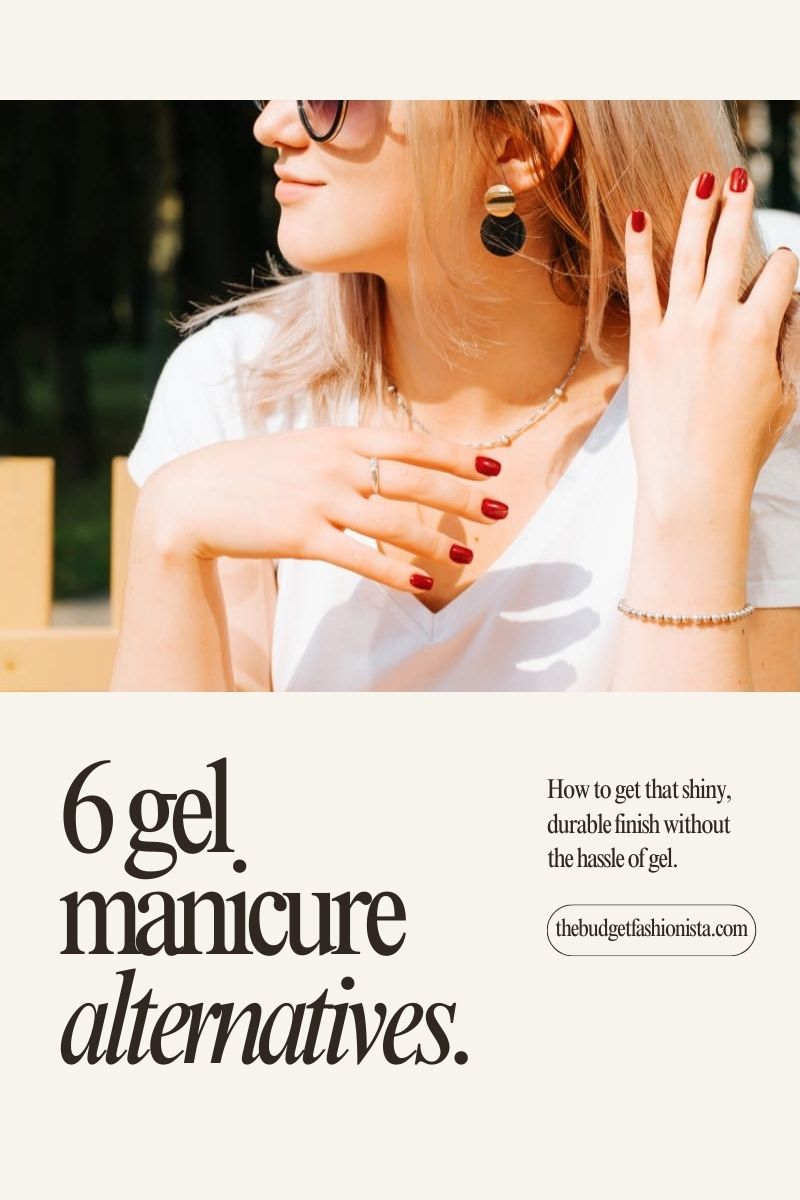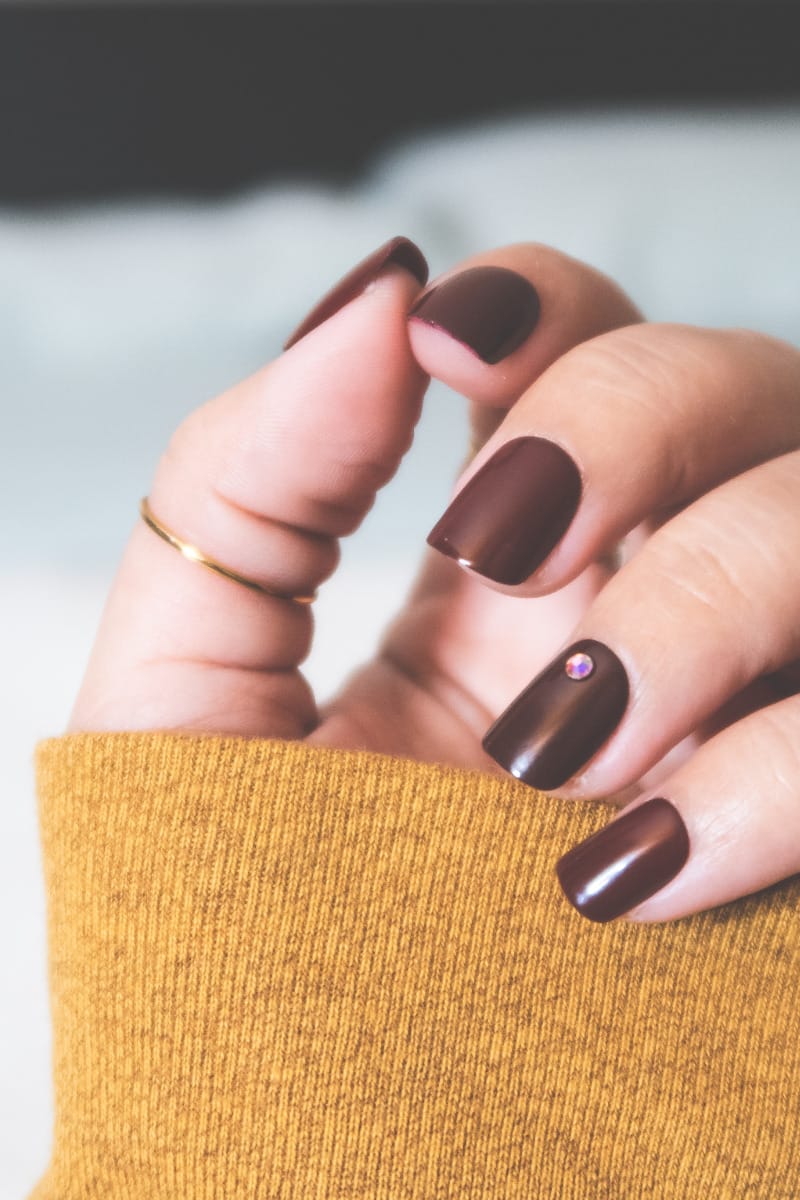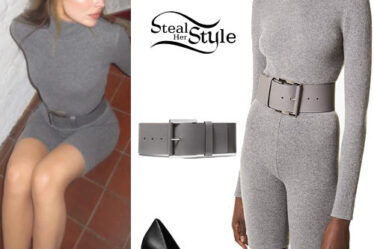
Love that shiny, durable finish of a gel manicure, but hate the hassle? I hear ya. Every time I get a gel manicure, I’m like, wow, my nails look amazing. But two weeks later, I’m over it. I start to pick at my nails until the gel polish comes off, one piece at a time.
Fortunately, gel polish does not have a lock on that smooth, chip-resistant finish. Below is a debrief on eight popular alternatives to the gel manicure. Each overview includes the pros and cons, nail health consequences, and maintenance and costs.


1. Acrylic nails
Acrylic manicures use an acrylic powder and a liquid monomer to add a durable layer over the top of your natural nail. The substance is thick and hard enough to add length and shape to your natural nail. Regular polish then goes on smoothly for a gel-like finish.
The acrylic process is generally done by a nail technician. You could buy the equipment and attempt to do it at home, but I don’t recommend it. Acrylic nails are very challenging to DIY. Plus, improper application can lead to painful broken nails.
From my perspective, acrylic nails work best for ladies who want a perfect finish, want longer nails, and have the time and money for regular nail maintenance. It’s also useful if you don’t type for a living or play contact sports.
Pros of acrylic nails
- Acrylic nails are tough.
- Polish goes on smoothly and dries to a nice shine.
- The acrylic process can extend your nails and reshape them.
Cons of acrylic nails
- Acrylic nails must be filled every two weeks or so.
- As nails grow out, the acrylic extension is more prone to breakage or separation from your natural nail.
- Acrylic nails don’t look natural. They’re thick and the base of the acrylic overlay stands out more as your natural nails grow.
- Acrylic nails aren’t practical for active lifestyles, unless you keep them very short.
Nail health
I’ve had acrylic manicures a few times in my life, so I can tell you: They’re rough on your natural nail. The trouble is, you won’t notice how bad your nails are until you stop getting acrylics. Your natural nails will be weak and brittle for some time after you have the acrylic removed.
Another issue I faced with acrylics is the potential for infection. Once I accidentally snagged the end of a nail on something, and it pulled my natural nail away from the nail bed. That was super painful. But then I had to manage an infection underneath my nail — which was gross.
Maintenance and cost
Initial application of acrylic nails can cost $50 to $100, depending on where you live. The process can take about two hours.
After the first application, you’ll need “fills” or “infills” every two to three weeks. You’ll spend $15-25 plus 45 minutes of your time on those. If any of your nails have come off, the fill process will take longer and cost more.
2. Silk wrap nails
Silk wrap nails were popular back in the ’80s, before acrylic nails became the standard. The silk wrap process involves applying a piece of silk or fiberglass to the nail with resin. The application strengthens the nail and prevents breakage. Silk wrap treatments can extend nails, too, but they’re not as thick or as tough as acrylics.
As with acrylic nails, you can buy the materials to do your own silk wrap manicure — but you’ll get better results from an experienced nail tech.
Silk wrap nails are a good fit for you if you prefer a natural-looking manicure that helps prevent breakage. They also last longer when they’re kept somewhat short.
Pros of silk wrap nails
- Silk wrap nails look more natural than acrylics.
- The silk wrap treatment strengthens your natural nail.
- You can use silk wraps to repair nail cracks. Consider them a more involved alternative to the tea bag nail fix.
- These are a good alternative for women with chemical allergies who cannot tolerate acrylics or gels.
Cons of silk wrap nails
- Silk wrap treatments aren’t a permanent solution. Keep them on consistently and they could damage your natural nail.
- This treatment might be difficult to do yourself.
- Silk wrap nails aren’t as hard as acrylics or gel manicures.
- Silk wrap nails require fills every two weeks.
- Your silk wraps could come off, especially if your nails are exposed to a lot of water.
Nail health
Silk nail wrap treatments are less damaging than other treatments. However, it’s important to follow proper procedures for removal — soak your nails rather than pulling them off, for example. As well, don’t keep your silk wraps on permanently. Give your nails a break from treatments occasionally so they can breathe.
Maintenance and cost
Silk wrap manicures are comparable in cost to acrylics. You’ll likely pay $50 or $100 for the initial treatment. Fills will be $25 to $50, depending on where you live and if the fill-in is with powder or overwrap.
3. Dip powder manicure
Dip powder manicures use a base coat, followed by a colored acrylic powder. An activator solution goes over the top to harden and seal the colored powder. The dip manicure process is relatively quick and doesn’t require UV light.
You can get a dip manicure at a salon or invest in a DIY dip starter kit for at-home use.
Dip powder nails are a good option if you want realistic-looking nails with a durable color coat. The polish can last three to four weeks.
Pros of dip powder nails
- Dip manicures look more natural than acrylic nails.
- Dip powder polish is long-lasting.
- You can DIY your dip manicure.
- No UV lights are required.
Cons of dip powder nails
- Repeated dip manicures can weaken your natural nail.
- There are hygiene concerns when you’re getting the manicure done at the salon. True story: My daughter got nicked on her cuticle with a file and the technician dunked her bleeding finger into the tub of powder. Note that the tub is like a bottle of polish; it gets reused for everyone. So…yuck.
- The dips may include irritating ingredients.
Nail health
The biggest risk to your nail health with a dip manicure is the repeated filing and lack of air supply to your natural nail. With repeated treatments, your nail can become weak and brittle.
Maintenance and costs
Dip manicures are comparable to gel manicures with respect to cost and maintenance. Each treatment will probably cost you $50 to $75. Alternatively, you can buy a DIY starter kit for $15 to $35.
To remove dip powder polish, you have to soak your nails in polish remover and gently scrub away the color.
4. Builder gel nails
Builder gels are lightweight, brush-on products that mimic the look of gel manicures and dip nails, but are less damaging. You might see them referred to as BIAB, which stands for builder in a bottle. These products generally require a base coat first and curing with a UV light. You can use builder gels to extend and reshape nails, which is an advantage over standard gel manicures.
You can also buy BIAB nail kits to use at home. Note that lengthening your own nails with a builder gel will likely be challenging. It’s far easier to use builder gel to strengthen your natural nails without adding length.
Pros of builder gels
- Builder gel manicures, applied properly, are more durable than gel manicures. Your nails could pass the three-week mark without chipping.
- Builder gels can extend or reshape your natural nail.
- Builder gel nails are stronger and lighter vs. gel manicures.
Cons of builder gels
- The gel can be an irritant to women with allergies.
- A UV light is required for curing.
- Improper application or removal of the builder gel can damage your nails.
Nail health
The gel substance itself normally isn’t caustic to your natural nail. But like other manicure types, there’s risk of damage in the application and removal processes. To remove builder gel, you have to cut off any extended length and file down the thickness before soaking your nails in an acetone nail polish remover.
Maintenance and costs
Builder gel manicures cost $50 to $100, with fills carrying a lower price tag. You can also buy starter kits with UV lamps for about $20 to $30 on Amazon.
5. Press-on nails


Press-on nails are pre-polished, artificial nails that attach over your natural nail with an adhesive. They are readily available at Walmart and beauty supply stores. Press-on nails come in kits with a variety of sizes to fit all 10 of your fingers. You can also buy press-on toenails.
I like press-on nails because they’re inexpensive and low-commitment. I find they’re prone to popping off if you use your hands a lot, though. But if you need a quick nail overhaul for a night out or for a relaxing beach weekend, these fit the bill for a low price tag.
Pros
- Press-on nails are available in many shapes and nail art designs.
- You can file press-on nails to customize the look.
- Press-on nails are easy to apply.
Cons
- Press-on nails aren’t as durable as other options. They can snag on things and pull right off your nail.
- Press-on nails may look less realistic than other types of manicures.
- If a press-on nail is loose, it can encourage you to pick at it until it comes off. That can cause damage to your nail underneath.
Nail health
Press-on nails won’t destroy the health of your nails on their own. You do risk nail damage if you pick at leftover adhesive or yank the nails off without soaking them first.
Maintenance and costs
Press-on nails are maintenance free. Once you’re done with them, soak them in polish remover, take them off, and throw them away. If you want to keep your pretty nails, simply buy another kit for $10 or less.
6. Regular manicure
Regular nail polish applied at home with a durable top coat and base coat is an economical alternative to a gel manicure. The downside is that regular polish tends to chip faster than gel polish.
I’ve found a reasonable middle ground with the DIY gel-like polishes that don’t require UV curing. I’ve had good luck with Revlon Colorstay. For best results, use the line’s base coat and top coat and apply multiple color coats.
Pros
- Regular nail polish is inexpensive and readily available.
- Your options include mainstream brands plus indie brands that often use vegan ingredients and fewer chemicals.
- Removing regular nail polish is simple.
- Most regular nail polishes, used properly, does not cause damage to the natural nail.
Cons
- Cheaper polishes can chip easily.
- Most standard polishes have little strengthening power.
Nail health
A traditional manicure involving a cuticle treatment can improve the health of your nails. As with other manicures, picking at your nails or polish can be destructive to your nails. For more information, see my post: What manicure is best for your nail health.
Maintenance and costs
You can get a basic salon manicure for $20 to $40. You can also spend that much on high-quality polish, base coat, and top coat — plus a good bottle of nail polish remover.
Maintenance is minimal. Swipe away your color coat when it starts to look haggard. And, keep your nails filed to a reasonable length to minimize breakage.
Branded gel nail products
There are also a few branded products that position themselves as gel manicure alternatives. These include:
- Polygel is a brand of builder gel made by Gelish.
- Shellac is a branded gel system made by Creative Nail Design (CND). Shellac doesn’t require you to buff away your natural nail before application, which is a plus.
- Plexigel is a gel-based product made by OPI
- IBX is a nail treatment that strengthens nails. It’s typically used underneath a gel manicure.
- Bio Sculpture is a branded traditional gel system that promises better nail health.
Your best manicure
The best gel alternative for you depends on what you want. If you prioritize a finish that lasts without chipping, try a dip manicure. Or, if you prefer not to commit to a certain shape or color, press-on nails are the answer. Whatever nail strategy you take, follow the product’s instructions for application, care, and removal so that your natural nails remain as healthy as possible.



